9 out of 10 marketers say approval delays are the top reason to miss deadlines.
Social media marketing is one of the best ways to build a brand presence online. However, brands need to be extra careful in maintaining their social media presence because once a mistake is made, it remains online forever. Even if you find and delete it later, a good portion of the audience might have already seen your mistake.
The most significant weak spot is where the gear of a social media team gets stuck in the social media approval process. Mistakes can happen, but a social media approval workflow goes a long way to ensure that your brand is seen as a professional one on social media.
This guide will give you actionable tips to streamline your social media approval workflow so that your team members can collectively maintain a consistent brand presence on social media.
Table Of Content:
- What Is A Social Media Approval Workflow?
- Why Your Brand Should Have A Social Media Approval Workflow?
- 7 Steps To Develop An Effective Social Media Approval Workflow
- The Top Tool For Streamlining Your Social Media Approval Workflow: Statusbrew
You can directly jump to a section of your choice or keep scrolling.
Click here to download a detailed infographic on tips to develop a social media approval process for your business.
What Is A Social Media Approval Workflow?
Social media approval workflows are the processes and procedures that organizations use to review and approve content before it is posted on their social media channels.
Multiple team members frequently maintain social media profiles, and even a single post may go through several review stages before it is published.
A well-designed approval procedure defines all the users and steps involved in the processes of social content publishing.
Why Your Brand Should Have A Social Media Approval Workflow?
Reason #1: To Avoid Mistakes
Your social media profile is like your virtual shop. Making a mistake in your social media content, like a simple typo or grammar error, will make you look like you don't care.
Such small mistakes are bound to happen, not purposefully, by new hires and interns who are getting acquainted with your system. Having a social media approval workflow gives your team the time and space to proofread social media copies before publishing them, thus minimizing the chances of committing such mistakes.
Reason #2: To Ensure Content Goes Out On Time
Posting on social media at a consistent time is vital for your brand’s online presence, as when you remain consistent in publishing, the algorithm also favors you. But it's hard to maintain that consistency if your workflow is not streamlined.
When your audience doesn't see a clear pattern of posting on social media, they feel that online marketing is not your brand’s priority.
Having a social media approval workflow will streamline different processes within the social media team, avoiding any delays and miscommunication, thus making each and every social content go out on time.
Reason #3: Increases Productivity
Social media approval workflow will help your team members understand what's required of them to gain quick approvals. For example, if the team members know that they have to follow specific guidelines to make the content piece approved, they won't waste time working in a direction that's not required.
In this way, a social media approval workflow will streamline the efforts of your marketing team.
Reason #4: Helps Maintain Consistency
An inconsistent look on your brand’s social media page doesn't convey any message to your audience. And this will not contribute to achieving your goal either.
By incorporating the social media approval workflow, your team members will be taking out time to maintain the consistency of your brand on its social page.
Having a consistent look on your brand’s social media page will deliver your brand’s core message to your audience, thus connecting and building trust with them and resulting in increased engagement and reach.
Reason #5: To Ensure Social Media Compliance
Social media has a different and important set of rules for business purposes. Hence, businesses need to be extra careful not to post any false or misleading information. This especially holds true for regulated sectors such as healthcare, finance, healthcare, government, etc.
It will be ensured during the approval process that these content pieces meet company policies and governance guidelines.
Know more: Social Media Compliance For Regulated Industries
Reason #6: Ensures The Security Of Your Brand
Once multiple team members have access to your brand's social media accounts, it becomes impossible to know who exactly used it. Multiple logins using the same passwords bring a concern for data breaches.
Using a social media approval workflow tool that provides SSO login allows you not to compromise your company's security.
7 Steps To Develop An Effective Social Media Approval Workflow
Step #1: Develop The Purpose
Step #2: Delegate Roles Within The Team
Step #3: Prepare Brand Guidelines
Step #4: Set Clear Expectations For The Approvers & Decide Timelines
Step #5: Optimize For Different Social Media Platforms
Step #6: Schedule Posts
Step #7: Analyze To Improve
Step #1: Develop The Purpose
The first step to planning a social media approval workflow is to define its purpose and role within your marketing plan.
Your social media team will have goals discussed and defined for a particular piece of content. However, since so many team members will be involved in creating one content piece, your goal might lose track mid-way. Therefore, the approver must ensure that the purpose of the social media content piece is followed through the content creation stage.
The social media approval workflow differs according to the brand's needs and goals. According to the type of social media content, some steps of the approval process will be added or removed, but the core purpose of the approval process should remain the same.
It will also be different for different types of social media content.
Bonus Tip: Keep your social media approval workflow flexible and easily adaptable for different kinds of situations.
However, the two things you need to ensure while tweaking your social media approval workflow are:
- Your team members are aware of which social media approval workflow is currently being followed in the team.
- The core purpose of the social media approval workflow should remain consistent.
Step #2: Delegate Roles Within The Team
Everyone in your social media team should clearly know who’s responsible for which task. Assign roles and responsibilities to team members based on their knowledge, skills, and availability. This prevents any critical step in the social media content creation process from being missed.

Image Source: Disruptive Advertising
Along with knowing their own responsibilities, your team members should know whom they need to get in touch with for approval and deliveries.
Define how each role will flow into the next and allot deadlines to each role. This ensures that the social media content piece gets sent to the right approver at the right time.
Define a process to collate and send feedback to the team members. It's best to batch feedback to avoid too much back-and-forth communication.
Protip: Reduce the number of approvers
Don't make a line of approvers, as this would further slow down your team’s progress. Instead, involve only the person who is required in the approval process. In this way, you will also be minimizing unnecessary edits.
However, having just one approver for the entire social media team might halt the workflow when that approver is not available. Hence, try to have two or more approvers so that teamwork is never stopped, and there's always someone to take up the approver’s role in their absence.
Find the correct balance for the number of approvers such that neither your team has too many approvers nor does the team's work gets halted in their absence.
Step #3: Prepare Brand Guidelines
Before your team members even start with the content creation process, they need to understand the guidelines to be followed and the expectations. This will give them the correct direction to work from the start itself, thus minimizing the edits.
Brand guidelines are the ones that differentiate your brand from the rest, and hence any and every piece of content that goes out on your brand’s social media page must adhere to those guidelines.
Your brand guidelines will broadly include the following aspects:
- Color pallet
- Typography
- Imagery
- Logo design
- Brand tone and voice
- Policies
Ask your team members to stick with these guidelines while progressing with their work.
Protip: Prepare templates
Keeping templates ready for most common types of social media content saves time and maintains design consistency. Using templates will ensure that your social media content will stay on brand no matter who is creating it.
Everyone on your team must be able to find the latest version of these templates. So rather than maintaining a disorganized template library, create a brand asset library that gives all your team members easy and on-demand access to all the brand assets in one place.
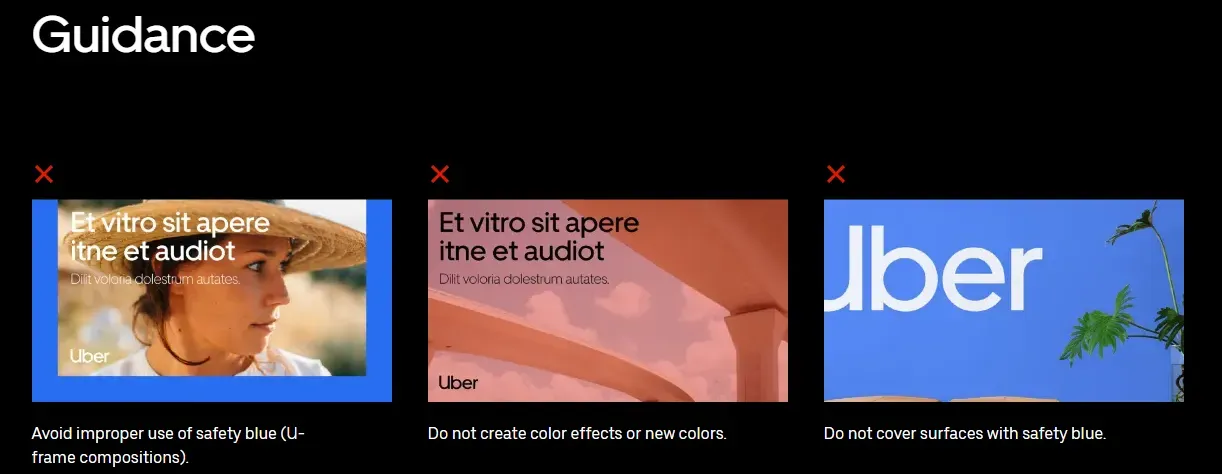
Image Source: Uber
Statusbrew’s Asset Manager maintains a pool of your brand’s digital content, making it easily shareable with your team members. You can filter the assets, quickly choose the stored content and schedule it with a click of a button.
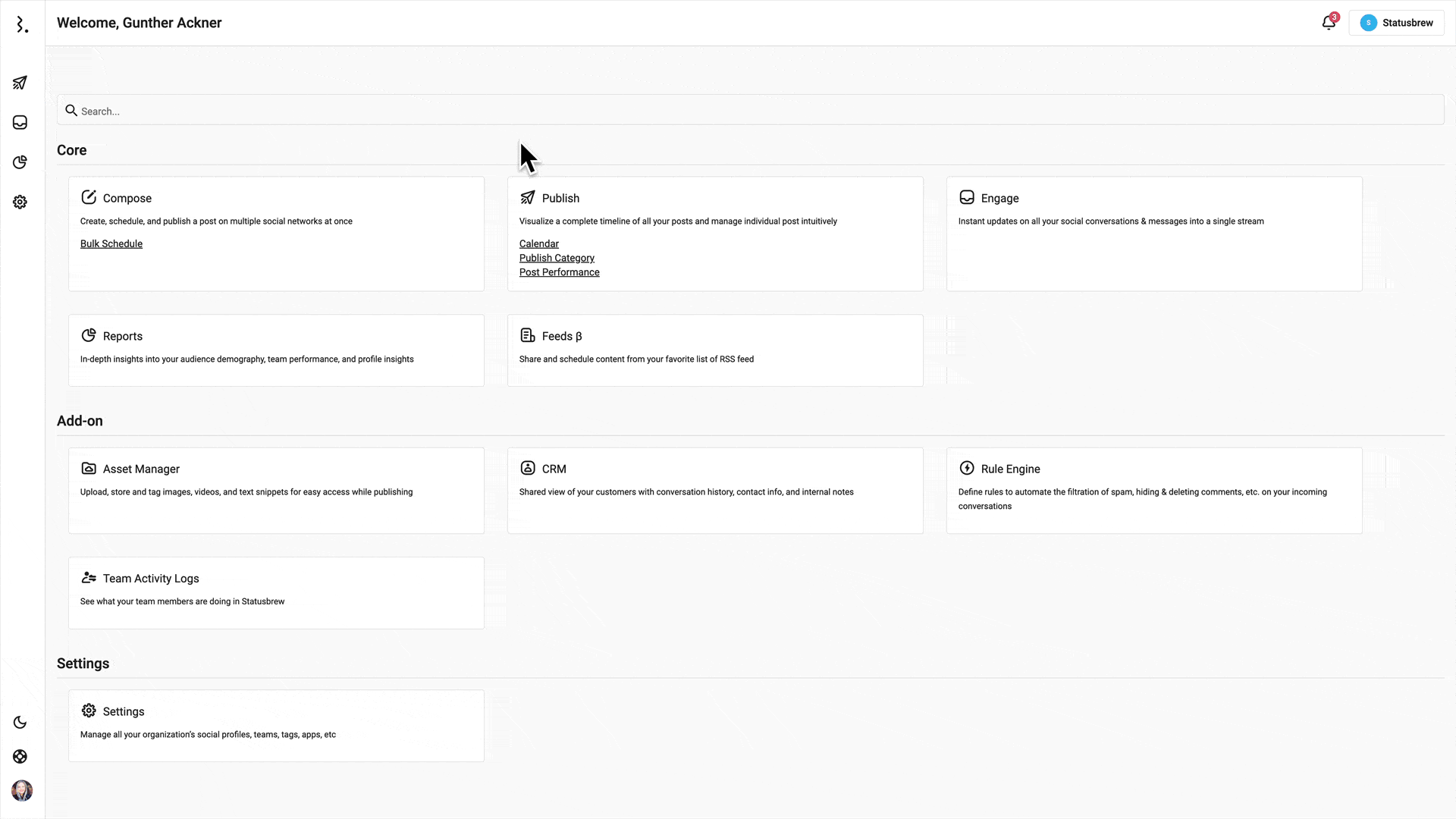
With all the brand guidelines in place, you might feel as though the formatting of social media platforms is restricting you, but you still have creative control over your brand's tone and voice.
Step #4: Set Clear Expectations For The Approvers & Decide On Timelines
In some social media teams, approvers are unsure of what's expected out of the social media approval workflow. Usually, such teams have a lot of approvers for a single content piece.
That's why the approvals must be aware of what's expected of them to make the entire social media content creation and publishing process more efficient. Proper communication between the creators and approvers will improve the team's social media marketing efforts and give better results.
Develop an approval outline that lists all the crucial details, such as the allotted time for review of each content piece and how feedback should be provided, and share it with the approver. This will make the approval requests clear and consistent, so the entire team is on the same page to minimize any delay or confusion in the approval process.
A single piece of social media content will have several stages of creation. Different team members would be responsible for different stages. To make the entire piece of content ready for approval, divide and set a timeline for each team member involved in the creation process.
When everyone completes their part on time, the content will be prepared on or before its actual timeline. Assign each stage of the content creation a deadline and ensure that each team member is responsible for adhering to their deadlines.
Step #5: Optimize For Different Social Media Platforms
If you want your brand to thrive on social media, optimizing isn't a choice; it’s a necessity.
You want your content to be found by the right people that form a part of your target audience.
Today, it’s not about ‘get the traffic’ — it’s about ‘get the targeted and relevant traffic. — Adam Audette.
Each social media platform has different requirements when it comes to posting content. Ignoring them will have a negative impact on how your content looks on social media.
Here are a few best practices for optimizing your social media content:
- The heading should fit the designated heading width of the platform.
- Easy sharing of content should be ensured with social sharing icons.
- Images should be of high quality and should appear attractive on social channel.
- Your content should offer value to its users, thus making it shareable.
- Use original content to emerge as a thought leader in your niche.
- Use appropriate hashtags to increase reach and avoid stuffing unnecessary hashtags.
- As long as possible, use original images and avoid using stock photos.
- Use the correct image dimensions when posting images.
- Include your brand’s logo in the images you post and your company name / URL in the text.
- Be relevant.
Protips:
- You can use analytics to determine the kind of content to create that interests your audience.
- Previewing your post while scheduling in social media management tool like Statusbrew will allow you to adjust your content, ensuring that the most critical information is visible to your audience. Statusbrew's Compose feature enables you to preview posts while creating them and customize posts according to each social platform.
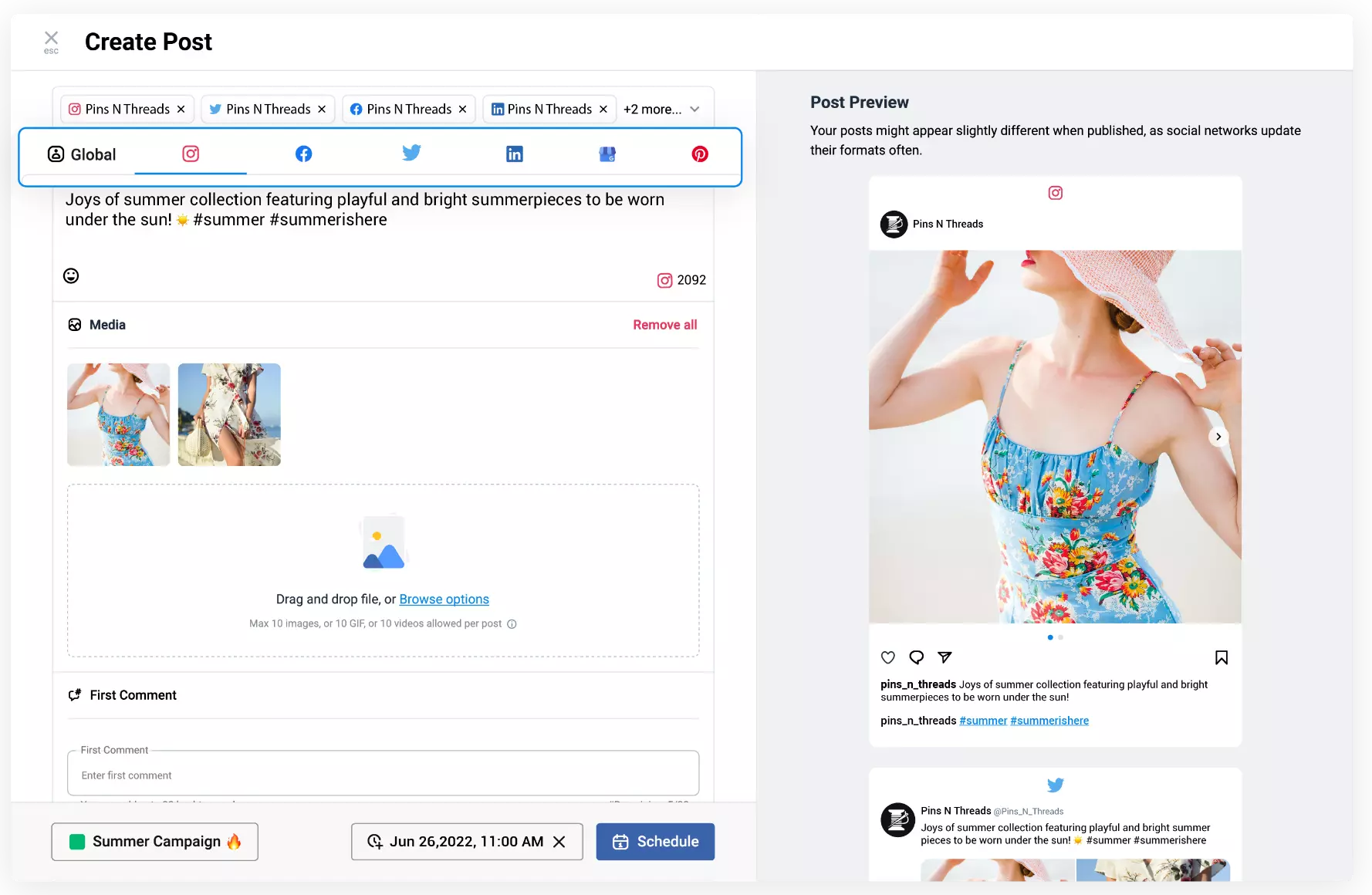
Step #6: Schedule Posts
You want to work smarter and not harder. Hence logging into every social media account each day to post is very time-consuming. Social media management tools come in handy for scheduling content at the best possible time. They help to keep your brand’s social up-to-date without being a time-consuming process for your team. This will save a lot of your team’s time while ensuring that content goes out on social media without any delay.
Read more: Social Media Scheduling: How To Do Like A Pro
Built into Statusbrew is a scheduling interface that allows linking multiple social accounts. You can easily choose images and videos from the Asset Manager and upload them with a few clicks. Select an appropriate time for the post to go live, and voila! Your content will be automatically made live on your social account while you are sleeping or traveling!
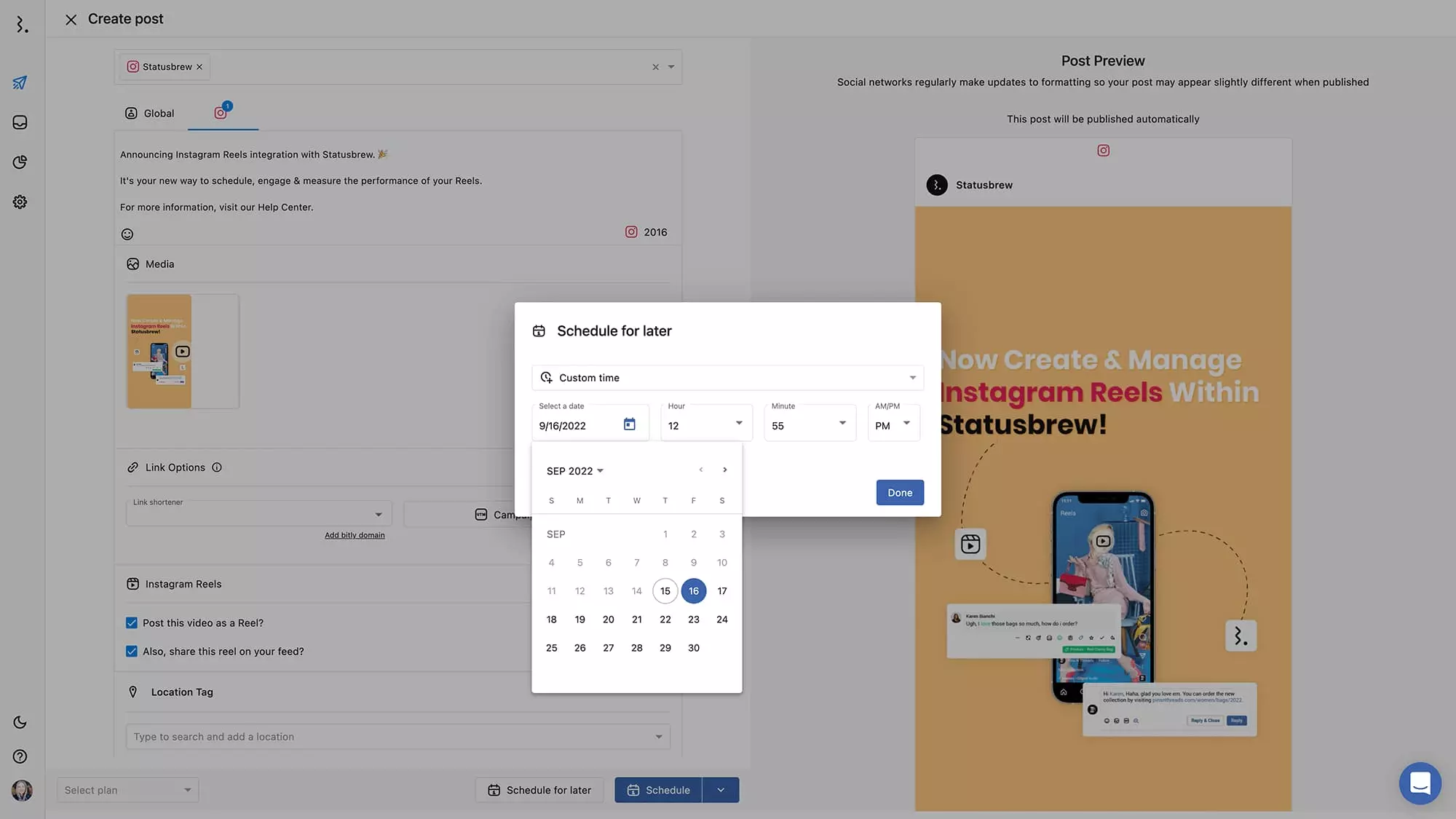
Step #7: Analyze To Improve
Periodically, you should be analyzing the flaws and bottlenecks in your social media approval workflow to improve on it. Identify which step in your approval process is inefficient, and that is delaying the entire process.
Collect team data regularly and evaluate it to know who’s slowing the process and figure out how you can improve. Keep a trial of the social media approval workflow at regular intervals and adjust it as required to achieve your goals. Also, stay updated about your brand’s latest regulations and compliances and adapt your approval workflow based on these changes when necessary.
Analyze your brand’s social media analytics to get a deeper comprehension of your team’s social media efforts and user behavior.
Statusbrew provides 180+ metrics to analyze your social performance in depth with some ready-made templates such as a Facebook performance report, YouTube channel report, Tag performance report, Instagram overview report, Twitter overview report, and more. In addition, it also allows you to create customizable reports to measure the metrics that matter most to your brand.
Learn more: Top 4 Social Media Marketing Metrics And Their Objectives
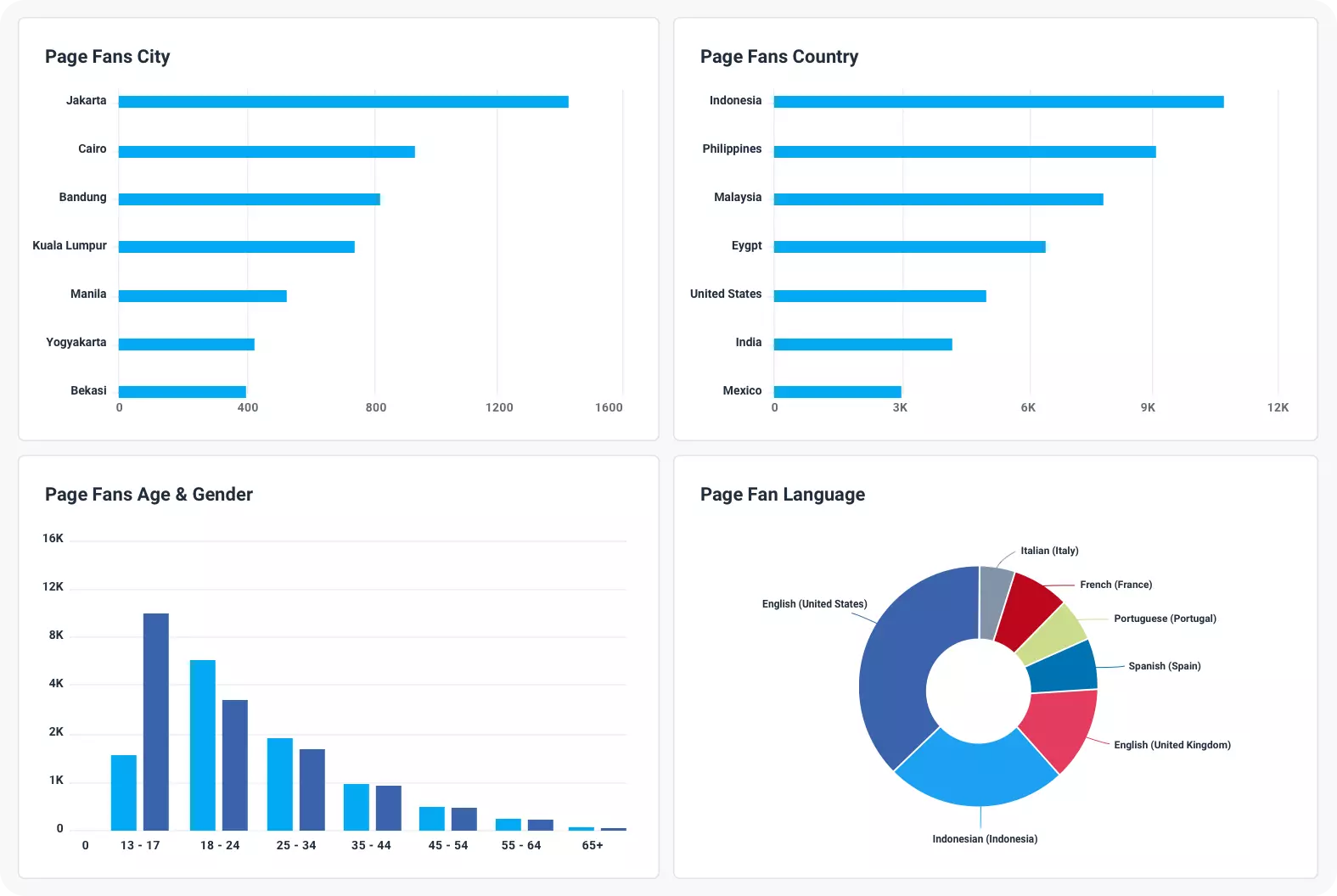
The Top Tool For Streamlining Your Social Media Approval Workflow: Statusbrew
Statusbrew's Approval Workflows help teams collaborate on creating social media content using customizable multi-step and multi-user workflows. Workflows facilitate submitting, reviewing, approving, or rejecting outgoing posts on your social accounts.
Key Features
Create Customized Multi-level Approval Workflows
Statusbrew allows to set up tailored content approval workflows involving multiple stakeholders. You can add as many steps as you want in your approval workflow and assign team member(s) at each step.
Each step can have one or multiple approvers, but just one user's approval is required to complete each step. You can also add a meaningful name to each level to properly group your approvers.
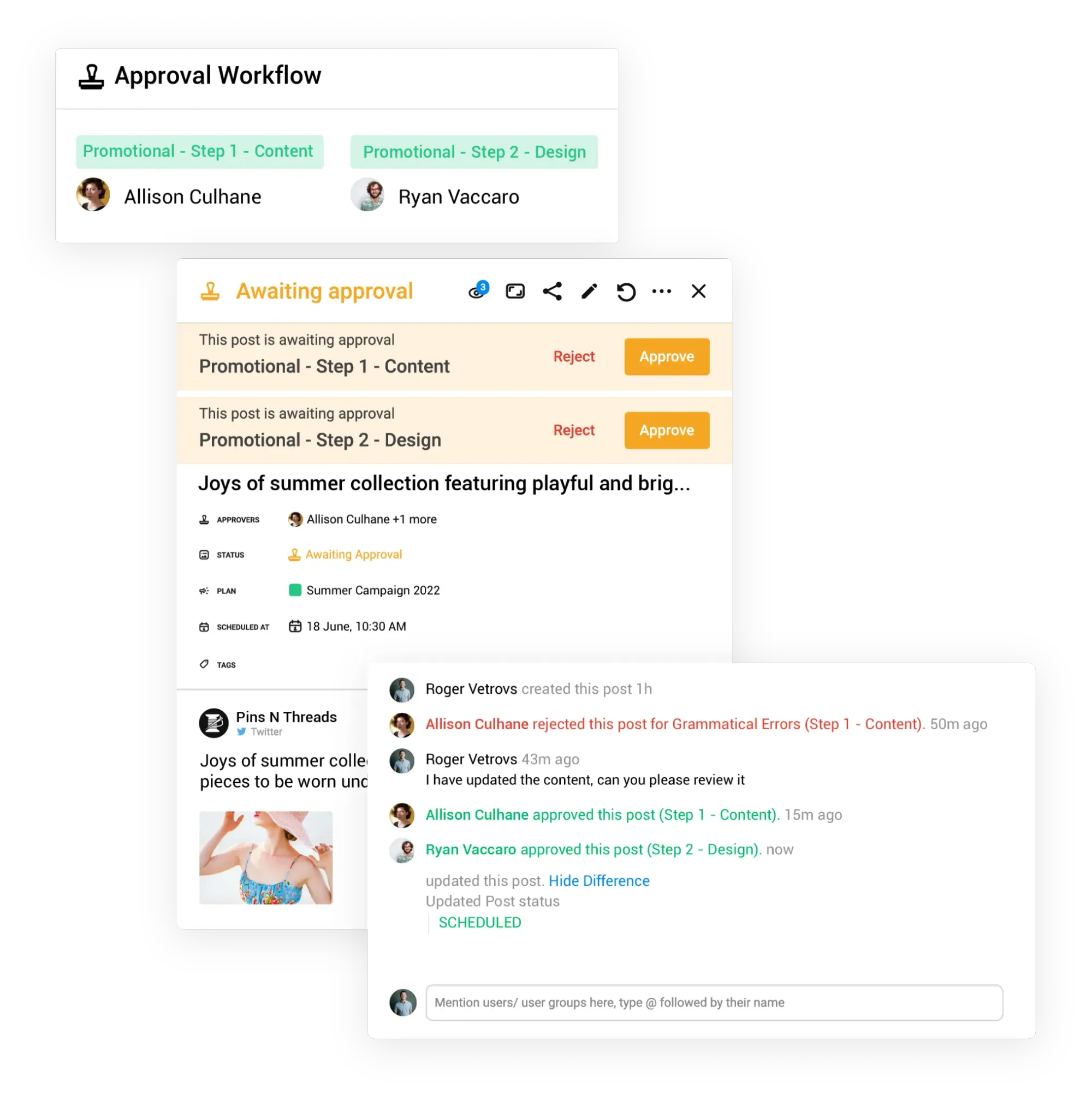
See A List Of All Posts Awaiting Approval
Posts that are awaiting approval will appear neatly under Statusbrew’s content calendar. The original submitter of the post can click on the scheduled post and even edit its content. Approvers can filter all the posts awaiting approval from the Planner.
Receive Notifications
Users that are a part of the workflow of creating and approving the posts will receive an email/mobile/desktop or slack notification when the message is submitted.
Add Rejection Reasons For Rejected Posts
While rejecting a post, you can add the reason for rejection as well. In fact, we have added a few most commonly used rejection reasons. You can even update these and add more rejection reasons from the App Settings.
The author of the post will find the rejected post in their Rejected section. They can click on any rejected post to view the approver's rejection reason and notes. Then, they can edit and resend it for approval or delete the post altogether.
Define Team Member Access
Statisbrew gives you the flexibility of defining who has the publishing abilities for specific social profiles.
For instance, team members with the "Create Post (Needs approval)" permission cannot get their posts published without approval.
Users with full publishing permission can skip steps on the approval workflow and move to directly publishing content from the Statusbrew dashboard.
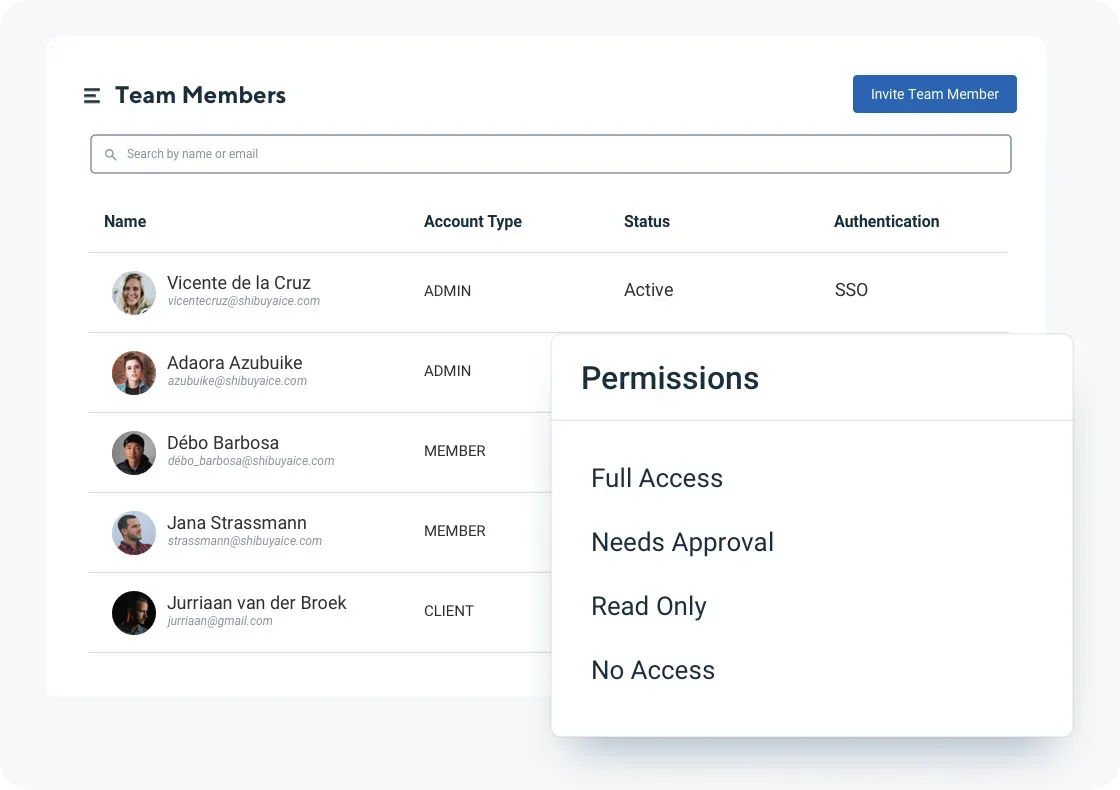
Customer Reviews
Statusbrew streamlined our social media marketing team's communication. The platform's approval workflow has been a game-changer for our team. It ensures that everyone is on the same page and that all content is thoroughly reviewed and approved before it's published. Highly recommend!
Customer Ratings
| G2 | Capterra |
|---|---|
| 4.7/5 | 4.8/5 |
Book a free demo today to start implementing such a streamlined social media approval workflow within your team!
Statusbrew is an all-in-one social media management tool that supports Facebook, Instagram, Twitter, Linkedin, YouTube, and even Google My Business.
Infographic

Citation Policy: Please feel free to use these infographics in any commercial or non-commercial capacity. If you use the infographics, we require a reference back to Statusbrew Blog.




Explore the Statusbrew range of social media tools
Cancel anytime!